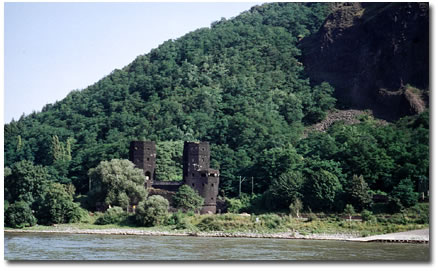|
|
|
|
|
|
 |
 |
|
|
| 9th
Infantry Division — World
War II — Remagen, Germany |
|
|
|
 |
 |
 |
 |
 |
 |
 |
|
The
twin tower remains of the
Ludendorff Bridge at Remagen,
Germany, are also still standing
on the eastern side of the
Rhine River at the base of
a 600-foot cliff of basalt
known as Erpeler Ley.
|
STORY FROM
EIGHT STARS TO VICTORY CONTINUED:
"The attachment came at 8 p.m.
for the 47th (the Raiders had
been chosen because they were nearest
to the bridgehead). Since instructions
had been issued to seize any available
bridge over the Rhine, (9th Infantry
Division commanding general) General
Louis A. Craig and his staff were
waiting, as were many other divisions,
to find out how the American Army
would cross the Rhine and — more
important to the men themselves —
who would be chosen to lead the way
over. When the moment came for action,
therefore, the Ninth was prepared.
General Craig was ordered over as
bridgehead commander and from then
on the watchword was speed.
"Colonel George W. Smythe led
his 47th Raiders in a grueling
nine-hour forced march over strange
and rugged terrain in blackout conditions,
and instantly upon arrival the 47th
Infantry went into the attack. During
the early hours of March 8th, 25-year-old
Lt. Colonel Lewis Maness boldly deployed
his 2nd Battalion over the bridge.
Crossing against heavy artillery and
other supporting fires, the 47th became
the first infantry regiment to battle
across the Rhine — Teutonic barrier
since the Napleonic Wars.
"As Colonel Smythe later explained,
this movement takes added significance
when it is considered that the time
the Raiders were ordered to
Remagen, they already had reached
their objective on the Rhine —
which was some 25 miles to the north.
The regiment moved to Remagen during
a miserable, rainy, inky black night
without benefit of any previous reconnaissance.
Trucks were furnished the regiment
as soon as they became available,
thus causing a piecemeal arrival of
battalions. To complicate this picture
further, the 2nd Battalion had to
detruck eight miles from the bridge
site and make its way over a narrow
winding road clogged with armored
vehicles. Thus, after having advanced
that day to the Rhine, these footsloggers
moved all night into what proved to
be one of the most costly and hard
fought battles of Raider history.
Much credit is due to the 47th Intelligence
and Reconnaissance Platoon, which
was ever dependable in guiding troops
on such occasions.
"The fighting engaged in by the
47th on March 8th was the beginning
of a bloody encounter for the Raiders.
Almost as soon as the regiment commenced
pouring into the bridgehead, Panzer
units from the north began approaching
the hilly region rimming the American
lines. At 4 a.m., the 2nd Battalion
of the 47th had arrived at the bridge
and began to cross immediately. Doughs
trudged up the hill to Orsberg and
then launched an attack across the
gently sloping rise toward the small
road center town of Bruchhausen. The
2nd overcame small-arms opposition
and by afternoon this battalion was
in control of the town." [ story
continued . . . ]
[ Back
to Photographs • Previous
Photograph • Next
Photograph ]
|
 |
 |
 |
|
|
 |
|
 |
|
|
|
|
|
|
|
|
|
 |
 |
|
